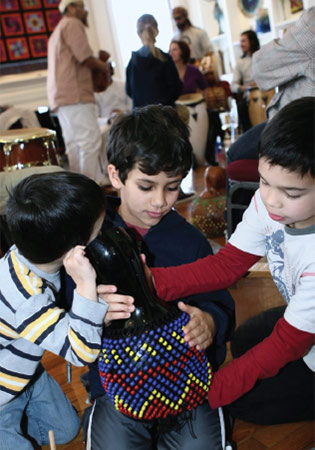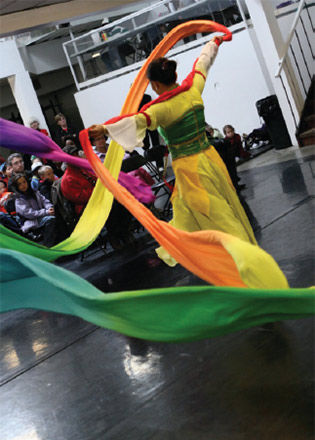By Noëlle Bernard
Break dancing, graffiti, hip-hop music and reggae steel drums are not traditionally associated with the word “art.” Instead, classical music, ballet and operas are typically what come to mind. However, in the Greater Cincinnati, Ohio region, a non-profit organization, ArtsWave, is attempting to change such thinking by introducing local communities to all forms of art.
In 1927, Cincinnati mogul Charles P. Taft and wife Anna Sinton founded the Cincinnati Institute of Fine Arts. The decision was based largely on the Tafts’ love for the city and desire to see it flourish. Moreover, the Institute’s original mission statement was “to further the musical and artistic education and culture for the people in Cincinnati.”
Upon founding the Institute, the Tafts asked members of the Cincinnati community to help raise $2.5 million to sustain the city’s art programs. Cincinnatians took up the challenge and were rewarded with a $1 million endowment from the Tafts.
During the early 1950s, the Institute created a subgroup—the Fine Arts Fund—designed to assist local arts organizations struggling financially. The fund was originally established as an annual campaign supporting the Cincinnati Art Museum, the Cincinnati Opera, the Cincinnati Symphony Orchestra and the Taft Museum. Eighty-three years later, the Institute had faded but the Fine Arts Fund remained.
In 2010, the Fine Arts Fund underwent another transformative process, changing its name to ArtsWave and expanding its mission.

Above, children play with a traditional drum. Reaching out to the whole community, including young people, is an integral part of ArtsWave’s mission.
“We’ve taken a very proactive stance in making changes in order to remain relevant and position ourselves for growth at a time where it would have been easy to ‘duck and cover’ with a tough economy,” said CEO and President Mary McCullough-Hudson.
Remaining relevant to local communities is important for the organization, which maintains a staff of 25 employees. The name change was a crucial part of this process.
“We picked that name [because] it gives a sense of movement and being part of a movement,” said Rebecca Bromels, director of communications at ArtsWave. “This is a community-driven organization in which we are trying to build benefits for the community in the arts.” The Fine Arts Fund was changed to ArtsWave following a survey launched by the organization to ask community members what they wanted from arts groups. From the results they redesigned the grant around two goals: connecting people and injecting new life into neighborhoods through the arts.
“People are increasingly coming to recognize how the arts create a real sense of place, whether it’s in a neighborhood or an entire region or city,” said McCullough-Hudson. “The arts can really distinguish and define communities in an age where everything starts looking homogenized.”
Currently, ArtsWave supports more than 100 arts organizations, including Elementz, a hip-hop dance company, the Cincinnati Symphony Orchestra, the Cincinnati Shakespeare Company, and the Children’s Theater of Cincinnati.
The goal is to help enhance communities by using art to link disassociated people and in turn change communities for the better.
“There’s more life and vibrancy when arts organizations are a part of a community,” Bromels said. “Especially in some of these neighborhoods, we’ve really seen how much they’ve blossomed because of the organic growth of arts organizations large and small.”
ArtsWave creates programs, workshops, and events throughout Cincinnati communities in conjunction with the arts groups they support. This year the communities they are focusing on are four counties in southwest Ohio (Hamilton, Butler, Warren, and Clermont), three counties in Northern Kentucky (Boone, Kenton, and Campbell), and one country in southeast Indiana (Dearborn), said Mike Boberg, director of Shared Services.
“We’re moving toward a more social impact model,” Boberg said. “Our service area is actually going to expand to cover our 15-county metropolitan service area.”
The new process is stricter, but according to Boberg, more effective at serving the community. One of the major changes to the organization revolves around the distribution of grants to arts groups. If an arts organization wants to receive funding through ArtsWave, that group must meet eligibility criteria and submit an application. “We fund non-profit organizations and they must have arts as a primary programming strategy,” Bromels said. “Then they go through a rigorous application process, which is evolving and changing.”
ArtsWave provides monetary grants in the thousands to millions of dollars depending on the community impact of an arts group, relates Bromels.

Above, scarf dancing; ArtsWave prides itself on the wide variety of art forms available to the public through their organization.
“ArtsWave community volunteers, who make up our grants board and grants allocation committees, make the decision along with ArtsWave staff, based on the grants application on how those dollars get allocated,” Bromels said.
In order to provide grant funding, ArtsWave relies on donations received from individuals, corporations, and foundations through the Annual Community Campaign.
The Annual Community Campaign also includes over 200 workplace campaigns at organizations both large and small. Individuals provide the largest portion of funding through these workplace campaigns. “Around 64 percent of total gifts come from individuals,” said Bromels.
Moreover, ArtsWave is largely fueled by volunteer support. Initiatives and programs like the 50-year-old Annual Community Campaign, the Multicultural Arts Program, ArtsWave Presents and Art Sampler Days all depend on volunteers. Likewise, a community volunteer can take up larger projects such as becoming a board member for one of ArtsWave’s supported arts organizations. ArtsWave promotes the program BOARDway Bound to train volunteers interested in sitting on the board of a local arts group. Typical volunteers come from the businesses targeted by the workplace campaigning, said Boberg.
“It’s about tapping into [people] wanting to give back and investing some of themselves into the community,” Boberg said. But not everyone is convinced that a community arts movement will truly change the climate in Cincinnati’s inner city. Cincinnati resident Charles Wood wants his city to grow and crime rates to decrease but he is unsure if arts groups will be enough. In 2009, Cincinnati’s Over-The-Rhine received the top spot in a list of the top 25 most dangerous cities in the country by Neighborhood Scout Reports. The same organization reported that 24,801 crimes occurred in Cincinnati in 2011, which means there is a one in 12 chance of a person being a victim of a crime.
“I think that there needs to be some sort of industry in the inner city to help provide an economic impact on the city,” Wood said. “A place like Over-The-Rhine is one of the problem areas, but if they think ArtsWave will work, then [they should] do it, because Cincinnati is desperate at this point.”
Indeed, ArtsWave’s long history proves that it likes a challenge. Strides are being made to ensure that the organization reflects the needs and interests of the served communities. The arts are helping communities improve economically because of ArtsWave’s belief in the “ripple effect of the arts,” said McCullough-Hudson.
“What has happened in this community, starting with Ensemble Theater and Music Hall and what’s built up around it, is a kind of color and life,” McCullough-Hudson said. “This then results in increased safety and increased revenue for restaurants and shops.”
More specifically, the organization is promoting organizations that are diverse in ethnicity, artistic style and sound. Even though ArtsWave’s current staff lacks ethnic diversity, the organization compensates by having a diverse board of trustees and a wide variety of arts groups that successfully reach out to diverse communities.
“We’ve also made a real effort to try and diversify our staff. It’s interesting because staff [are often] fluid in nonprofits,” Bromels said. “We had more diversity on our staff just a year ago, but as people have come and gone that’s changed a little bit. I think it will change back again in the other direction in the future. It’s certainly a priority.”
With a revamped name, mission, and funding strategy, ArtsWave in 2012 is focused on its revised programs and helping encourage local arts groups to join the movement.
“Truly successful organizations and businesses make the kinds of changes that we’ve made when you’re working from a position of strength,” McCullough-Hudson said. “It takes courage and we have a great board, great staff, and great arts organizations that have come with us on this journey. We’re not done yet and we still have to improve in our ability to engage a lot more people.”
Noëlle Bernard is currently working in Washington D.C. and hopes to secure a future as a reporter or writer on military affairs.






